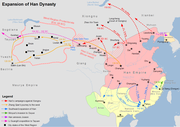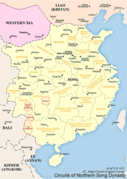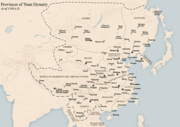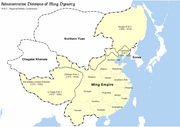This is a timeline of Yunnan and Guizhou.
4th century BC
| Year | Date | Event |
|---|---|---|
| 328 | Chu military commander Zhuang Qiao invades Yunnan and sets up the Dian Kingdom[1] |
2nd century BC
| Year | Date | Event |
|---|---|---|
| 135 BC | Tang Meng creates Jianwei Commandery (modern Zunyi)[1] | |
| 122 BC | Emperor Wu of Han sends envoys to the southwest in search of a route to Daxia[2] | |
| 111 BC | Zangke Commandery is created in modern Guiyang and Yelang is vassalized[3] | |
| 109 BC | Han conquest of Dian: The Dian Kingdom and Tian Kingdom become Han vassals and Yizhou Commandery is created in modern Qujing[3] |
1st century BC
| Year | Date | Event |
|---|---|---|
| 86 BC | Rebellion occurs in the southwest[4] | |
| 83 BC | Rebellion occurs in the southwest[4] | |
| 27 BC | Aboriginals rebel in the southwest[5] |
1st century
| Year | Date | Event |
|---|---|---|
| 12 | Aboriginals in Zangke Commandery (Guizhou) rebel[5] | |
| 14 | Aboriginals in Yi Province rebel[5] | |
| 45 | Aboriginals rebel in the southwest[6] | |
| 51 | An Ailao tribe defects to Han[7] | |
| 57 | Yongchang Commandery is created in modern Kachin State[6] | |
| 69 | An Ailao tribe defects to Han[7] |
2nd century
| Year | Date | Event |
|---|---|---|
| 107 | Aboriginals rebel in the southwest[6] | |
| 116 | Aboriginals rebel in the southwest[6] | |
| 123 | Aboriginals rebel in the southwest[6] | |
| 146 | Policy of assimilation in the southwest is implemented through education programs[4] | |
| 156 | Aboriginals rebel in the southwest[6] | |
| 159 | Aboriginals rebel in the southwest[6] | |
| 176 | Aboriginals rebel in the southwest[6] |
3rd century
| Year | Date | Event |
|---|---|---|
| 225 | Zhuge Liang's Southern Campaign: Zhuge Liang conquers Nanzhong[8] |
4th century
| Year | Date | Event |
|---|---|---|
| 338 | Cuan Chen of the Cuanman gains control over Yunnan[9] |
6th century
| Year | Date | Event |
|---|---|---|
| 570 | Cuan Zan splits his realm into the Wuman/Black Mywa, ruled by his son Cuan Zhen, in the east and the Baiman/White Mywa, ruled by his eldest son Cuan Wan, in the west | |
| 593 | The Cuanman rebel in Yunnan[9] | |
| 597 | A campaign is launched against the Cuanman[9] |
7th century
| Year | Date | Event |
|---|---|---|
| 602 | Sui defeats the Cuanman[9] |
8th century
| Year | Date | Event |
|---|---|---|
| 703 | Tridu Songtsen of the Tibetan Empire subjugates the White and Black Mywa[10] | |
| 737 | Piluoge (皮羅閣) unites the six zhaos (kingdoms) of the White Mywa with Tang support[11] | |
| 751 | Xianyu Zhongtong attacks Nanzhao with an army of 80,000 but is utterly defeated, losing three quarters of his original force[12] | |
| 754 | Yang Guozhong invades Nanzhao but fails to engage with the enemy until supplies ran out, at which time they were attacked and routed[12] |
9th century
| Year | Date | Event |
|---|---|---|
| 801 | Tang and Nanzhao defeat Tibetan Empire and their Abbasid slave soldiers[13] | |
| 829 | Nanzhao takes Chengdu and captures 20,000 Chinese engineers[14] | |
| 846 | Nanzhao raids Annam[15] | |
| 861 | Nanzhao attacks Bo Prefecture and Annam but is repulsed.[16] | |
| 863 | Nanzhao conquers Annam[17] | |
| 866 | Gao Pian retakes Annam from Nanzhao[17] | |
| 869 | Nanzhao lays siege to Chengdu but fails to capture it[18] | |
| 870 | Nanzhao lays siege to Chengdu (in Sichuan)[17] | |
| 877 | Nanzhao retreats from Qianzhong Circuit in modern Guizhou[18] |
10th century
| Year | Date | Event |
|---|---|---|
| 902 | Zheng Maisi murders the king of Nanzhao and sets up his own Dachanghe regime[9] | |
| 928 | Zhao Shanzhen kills the king of Dachanghe and sets up Datianxing[9] | |
| 929 | Yang Hefeng removes Zhao Shanzhen and sets up Dayining[9] | |
| 937 | Duan Siping defeats Dayining and creates the Dali Kingdom[9] | |
| 967 | Long Yanyao of Nanning, the Yang clan of Bo Prefecture, and the Tian clan of Si Prefecture submit to the Song dynasty in return for their autonomy[19] | |
| Song dynasty recognizes the Bole of the Luodian kingdom, the Mangbu of the Badedian kingdom, and the Awangren of the Yushi kingdom[20] | ||
| 975 | Emperor Taizu of Song tries to convince Pugui of the Mu'ege Kingdom situated in northwest, central, east, and southeast Guizhou to acquiesce to Song overlordship[21] | |
| 976 | Song dynasty and aboriginal allies in Guizhou attack the Mu'ege Kingdom, forcing them to retreat to Dafang County[22] | |
| 980 | Long Yanyao's grandson Long Qiongju presents tribute to the Emperor Taizong of Song[19] | |
| 995 | Long Hanyao of Nanning presents tribute to the Song court[19] | |
| 998 | Long Hanyao of Nanning presents tribute to the Song court[19] |
11th century
| Year | Date | Event |
|---|---|---|
| 1042 | Song dynasty appoints Degai of the Mu'ege Kingdom as regional inspector[22] | |
| 1043 | The Yao people of Guiyang rebel[23] | |
| 1049 | Nong Zhigao of the Zhuang people rebels in Guangnan West Circuit[23] | |
| 1051 | The Yao rebellion of Guiyang is suppressed[23] | |
| 1053 | Nong Zhigao's rebellion is suppressed[23] |
12th century
| Year | Date | Event |
|---|---|---|
| 1133 | Ayong of the Mu'ege Kingdom leads a large trade delegation of several thousand to the Song city of Luzhou in Sichuan[20] |
13th century
| Year | Date | Event |
|---|---|---|
| 1208 | Yao people rebel in Jinghu and are suppressed[24] | |
| 1252 | summer | Möngke Khan places Kublai Khan in charge of the invasion of the Dali Kingdom[25] |
| 1253 | September | Kublai Khan's forces set up headquarters on the Jinsha River in western Yunnan and march on Dali in three columns[25] |
| 1254 | January | The Dali Kingdom is conquered, although its dynasty remains in power, and the king, Duan Xingzhi, is later invested with the title of Maharajah by Möngke Khan; so ends the Dali Kingdom[26] |
| winter | Kublai Khan returns to Mongolia and leaves Subutai's son Uryankhadai in charge of campaigns against local Yi tribes[26] | |
| 1257 | Uriyangkhadai, son of Subutai, pacifies Yunnan and returns to Gansu[26] | |
| winter | Mongol invasions of Vietnam: Uriyangkhadai returns to Yunnan and invades the Trần dynasty of Đại Việt[26] |
14th century
| Year | Date | Event |
|---|---|---|
| 1332 | March | War of the Two Capitals: Loyalist rebels in Yunnan are defeated[27] |
| 1360 | Basalawarmi takes control of Yunnan[28] | |
| 1381 | December | Ming conquest of Yunnan: Ming forces take Qujing[29] |
| 1382 | April | Ming conquest of Yunnan: Ming forces conquer Yunnan[30] |
| 1386 | January | Ming–Mong Mao War: Si Lunfa of Mong Mao rebels[31] |
| 1388 | Ming–Mong Mao War: Mong Mao is defeated by the Ming artillery corps utilizing volley fire[32] | |
| 1389 | January | Ming forces defeat Yi rebels in Yuezhou[33] |
| December | Ming–Mong Mao War: Si Lunfa surrenders to the Ming dynasty[33] | |
| 1397 | December | Ming–Mong Mao Intervention: Si Lunfa is deposed and requests Ming aid in restoring him to power[34] |
| 1398 | January | Ming–Mong Mao Intervention: Si Lunfa is restored to power[35] |
15th century
| Year | Date | Event |
|---|---|---|
| 1438 | 8 December | Luchuan–Pingmian campaigns: Ming carries out a punitive expedition against Si Renfa of Mong Mao for attacking neighboring tusi, but fails to defeat him[36] |
| 1441 | 27 February | Luchuan–Pingmian campaigns: Ming forces attack Mong Mao[37] |
| 1442 | January | Luchuan–Pingmian campaigns: Mong Mao is defeated but Si Renfa escapes to Ava[38] |
| 1443 | March | Luchuan–Pingmian campaigns: Ming forces defeat Si Jifa but fail to capture him[39] |
| 1445 | August | Luchuan–Pingmian campaigns: Ava hands over Si Renfa to Ming in return for their support in attacking Hsenwi[40] |
| 1446 | January | Luchuan–Pingmian campaigns: Si Renfa is executed[40] |
| 1449 | March | Luchuan–Pingmian campaigns: Ming forces invade Mong Yang for harboring Si Jifa, but he manages to escape again[41] |
| 1450 | Miao rebellions under the Ming dynasty: Yao and Miao people rebel in Guizhou and Huguang[42] | |
| 1452 | Miao rebellions under the Ming dynasty: Yao and Miao rebels are suppressed[42] | |
| 1456 | Miao rebellions under the Ming dynasty: Miao people in Huguang rebel and are suppressed[42] | |
| 1464 | Hou Dagou of the Yao people rebels in Guangxi[43] | |
| 1466 | January | Ming forces defeat and capture Hou Dagou, but the rebellion continues anyway[43] |
| Miao rebellions under the Ming dynasty: Miao people rebel in Hunan as well as the Sichuan-Guizhou border and are suppressed[44] | ||
| 1475 | Miao rebellions under the Ming dynasty: Miao people rebel in Hunan and are suppressed[44] | |
| 1479 | Miao rebellions under the Ming dynasty: Miao people rebel in Sichuan[45] | |
| 1499 | Yi people rebel in Guizhou[46] |
16th century
| Year | Date | Event |
|---|---|---|
| 1502 | Yi rebels in Guizhou are suppressed[46] | |
| 1589 | Bozhou rebellion: Miao people rebel in Bozhou[47] | |
| 1592 | 14 July | Ordos Campaign: Ye Mengxiong brings cannons and additional Miao troops to the siege of Ningxia[48] |
| 1594 | Bozhou rebellion: Ming forces are defeated in Sichuan[49] | |
| 1598 | Bozhou rebellion: The Miao rebellion is suppressed[49] |
17th century
| Year | Date | Event |
|---|---|---|
| 1606 | Army officers in Yunnan riot and kill Yang Rong, a eunuch superintendent of mining[50] | |
| 1621 | fall | She-An Rebellion: Yi people rebel in Sichuan and Guizhou[51] |
| 1623 | She-An Rebellion: Ming forces are defeated[51] | |
| 1624 | She-An Rebellion: Ming forces defeat rebels but are unable to decisively quell the rebellion[51] | |
| 1629 | She-An Rebellion: The rebels are defeated[51] | |
| 1656 | March | The Yongli Emperor arrives in Yunnan[52] |
| 1657 | October | Sun Kewang's forces are defeated by Li Dingguo in eastern Yunnan and he retreats to Guizhou[52] |
| 1659 | 7 January | Qing forces advance into Yunnan and the Yongli Emperor flees to Toungoo dynasty[53] |
| 10 March | Qing forces capture Yongchang and defeat Li Dingguo's army, securing Yunnan[53] |
Gallery
-
Ancient southern China
-
Han conquest of Dian, 109 BC
-
Nanzhao, 879
-
Song dynasty, 1111
-
Dali Kingdom, late 12th century
-
Yuan dynasty, 1330
-
-
Qing dynasty, 1820
References
- ^ a b Twitchett 2008, p. 457.
- ^ Watson 1993, p. 236.
- ^ a b Twitchett 2008, p. 458.
- ^ a b c Twitchett 2008, p. 459.
- ^ a b c Twitchett 2008, p. 235.
- ^ a b c d e f g h Twitchett 2008, p. 460.
- ^ a b Twitchett 2008, p. 272.
- ^ Xiong 2009, p. lxxxviii.
- ^ a b c d e f g h Yang 2008a.
- ^ Beckwith 1987, p. 64.
- ^ Wang 2013, p. 103.
- ^ a b Graff 2002, p. 214.
- ^ Beckwith 1987, p. 157.
- ^ Herman 2007, pp. 33, 35.
- ^ Taylor 2013, p. 41.
- ^ Herman 2007, p. 36.
- ^ a b c Xiong 2009, p. cxiv.
- ^ a b Herman 2007, p. 37.
- ^ a b c d Herman 2007, p. 39.
- ^ a b Herman 2007, p. 43.
- ^ Herman 2007, p. 40.
- ^ a b Herman 2007, p. 42.
- ^ a b c d Twitchett 2009, p. 329.
- ^ Twitchett 2009, p. 831.
- ^ a b Twitchett 1994, p. 405.
- ^ a b c d Twitchett 1994, p. 407.
- ^ Twitchett 1994, p. 545.
- ^ Twitchett 1998, p. 72.
- ^ Twitchett 1998, p. 144.
- ^ Mote 2003, p. 557.
- ^ Liew 1996, pp. 163–164.
- ^ Andrade 2016, p. 158.
- ^ a b Twitchett 1998, p. 160.
- ^ Fernquest 2006, p. 47.
- ^ Fernquest 2006, pp. 47–48.
- ^ Liew 1996, pp. 174–175.
- ^ Liew 1996, p. 178.
- ^ Liew 1996, pp. 181–182.
- ^ Liew 1996, p. 184.
- ^ a b Liew 1996, p. 185.
- ^ Liew 1996, p. 192.
- ^ a b c Twitchett 1998, p. 336.
- ^ a b Twitchett 1998, p. 377.
- ^ a b Twitchett 1998, p. 380.
- ^ Twitchett 1998, p. 383.
- ^ a b Twitchett 1998, p. 381.
- ^ Lewis 2015, p. 209.
- ^ Swope 2009, p. 30.
- ^ a b Dardess 2012, p. 9.
- ^ Twitchett 1998, p. 531.
- ^ a b c d Dardess 2012, p. 10.
- ^ a b Twitchett 1998, p. 706.
- ^ a b Twitchett 1998, p. 707.
Bibliography
- Andrade, Tonio (2016), The Gunpowder Age: China, Military Innovation, and the Rise of the West in World History, Princeton University Press, ISBN 978-0-691-13597-7.
- Beckwith, Christopher I (1987), The Tibetan Empire in Central Asia: A History of the Struggle for Great Power among Tibetans, Turks, Arabs, and Chinese during the Early Middle Ages, Princeton University Press
- Crespigny, Rafe (2007), A Biographical Dictionary of Later Han to the Three Kingdoms (23-220 AD), Brill
- Dardess, John (2012), Ming China 1368-1644 A Concise History of A Resilient Empire, Rowman & Littlefield Publishers, Inc.
- Fernquest, John (2006), Crucible of War: Burma and the Ming in the Tai Frontier Zone (1382-1454)
- Graff, David A. (2002), Medieval Chinese Warfare, 300-900, Warfare and History, London: Routledge, ISBN 0415239559
- Graff, David Andrew (2016), The Eurasian Way of War Military Practice in Seventh-Century China and Byzantium, Routledge, ISBN 978-0-415-46034-7.
- Herman, John E. (2007), Amid the Clouds and Mist China's Colonization of Guizhou, 1200–1700, Harvard University Asia Center, ISBN 978-0-674-02591-2
- Lewis, James (2015), The East Asian War, 1592-1598: International Relations, Violence and Memory, Routledge
- Liew, Foon Ming (1996), The Luchuan-Pingmian Campaigns (1436-1449) in the Light of Official Chinese Historiography
- Mote, F. W. (2003), Imperial China: 900–1800, Harvard University Press, ISBN 978-0674012127
- Swope, Kenneth M. (2009), A Dragon's Head and a Serpent's Tail: Ming China and the First Great East Asian War, 1592-1598, University of Oklahoma Press.
- Swope, Kenneth (2014), The Military Collapse of China's Ming Dynasty, Routledge
- Taylor, K.W. (2013), A History of the Vietnamese, Cambridge University Press
- Twitchett, Denis (1994), The Cambridge History of China, Volume 6, Alien Regime and Border States, 907-1368, Cambridge: Cambridge University Press, ISBN 0521243319
- Twitchett, Denis (1998), The Cambridge History of China Volume 7 The Ming Dynasty, 1368—1644, Part I, Cambridge University Press
- Twitchett, Denis (1998b), The Cambridge History of China Volume 8 The Ming Dynasty, 1368—1644, Part 2, Cambridge University Press
- Twitchett, Denis (2008), The Cambridge History of China 1, Cambridge University Press
- Twitchett, Denis (2009), The Cambridge History of China Volume 5 The Sung dynasty and its Predecessors, 907-1279, Cambridge University Press
- Wang, Zhenping (2013), Tang China in Multi-Polar Asia: A History of Diplomacy and War, University of Hawaii Press
- Watson, Burton (1993), Records of the Grand Historian by Sima Qian: Han Dynasty II (Revised Edition, Columbia University Press
- Xiong, Victor Cunrui (2009), Historical Dictionary of Medieval China, United States of America: Scarecrow Press, Inc., ISBN 978-0810860537
- Yang, Bin (2008a), "Chapter 3: Military Campaigns against Yunnan: A Cross-Regional Analysis", Between Winds and Clouds: The Making of Yunnan (Second Century BCE to Twentieth Century CE), Columbia University Press
- Yang, Bin (2008b), "Chapter 4: Rule Based on Native Customs", Between Winds and Clouds: The Making of Yunnan (Second Century BCE to Twentieth Century CE), Columbia University Press
- Yang, Bin (2008c), "Chapter 5: Sinicization and Indigenization: The Emergence of the Yunnanese", Between Winds and Clouds: The Making of Yunnan (Second Century BCE to Twentieth Century CE), Columbia University Press









